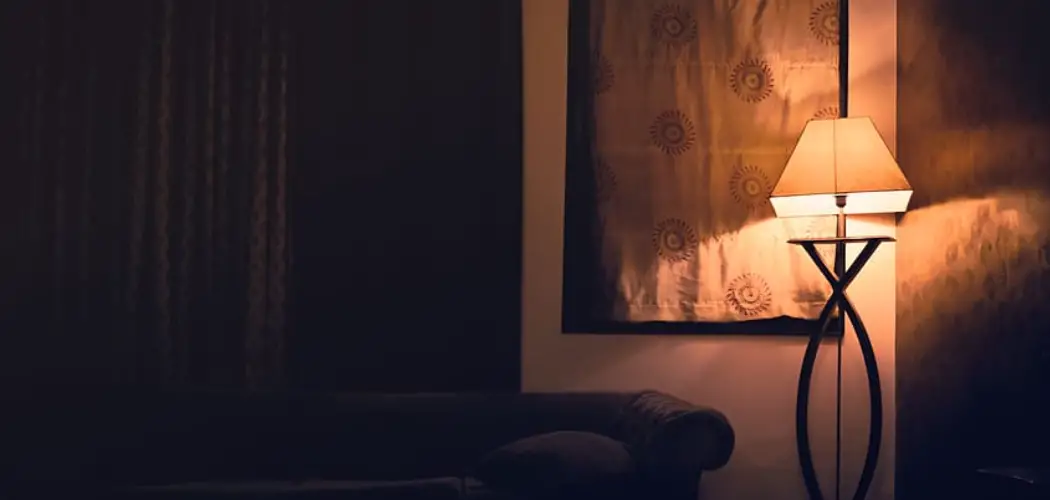When it comes to décor and creating the right ambiance in your living room, lighting plays a significant role. And one of the most versatile lighting options for any living room is lamps. Lamps not only provide additional light but also add character and style to your space.
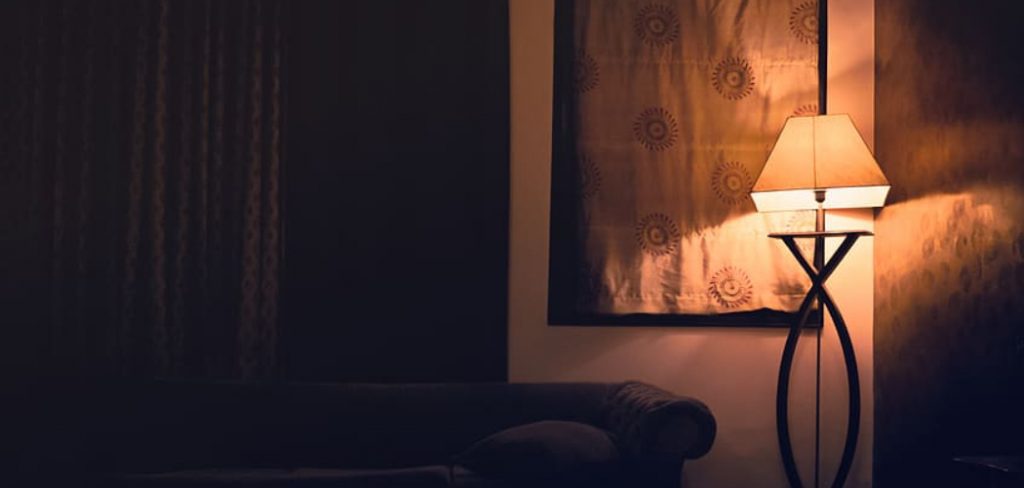
But placing lamps in the right spot can be tricky. As we have discussed earlier, lamps are an essential element in any living room. They not only provide functional lighting but also add a touch of style and ambiance to the space. In this section, we will discuss some tips on how to place lamps in living room effectively.
Necessary Items
Before we dive into the tips, let’s first go over the necessary items you will need to place lamps in your living room:
- Lamps: Of course, you will need a lamp or multiple lamps depending on the size of your living room and your personal preference. There are various types of lamps available, such as table lamps, floor lamps, and wall sconces.
- Bulbs: Make sure to choose the right type of bulbs for your lamps. Depending on the height of your lamp and the ambiance you want to create, you can opt for warm or cool-toned bulbs.
- Power Outlets: To ensure that your lamps are functional, make sure there are enough power outlets available in the area where you want to place them. If not, consider investing in extension cords or hiring an electrician to add more outlets.
- Furniture: The placement of your furniture plays a crucial role in determining where your lamps will go. Make sure to arrange your furniture in a way that allows for easy access to power outlets and creates a balanced layout.
8 Things to Know Before You Start
1) Consider the Size and Scale
When choosing lamps for your living room, it’s important to consider the size and scale of both the room and the lamp. A small lamp may get lost in a large living room, while a big lamp can overpower a smaller space. Similarly, if you have low ceilings, opt for shorter lamps that won’t add too much height to the room.
2) Think About Functionality
Before placing lamps, consider the functionality of your living room. Do you need a bright light for reading or a soft ambiance for movie nights? This will help you determine the type of lamp and bulb you need.
3) Balance is Key
Balance is crucial when it comes to placing lamps in your living room. If you have one lamp on one side of the room, make sure to add another on the opposite side to create symmetry and balance.
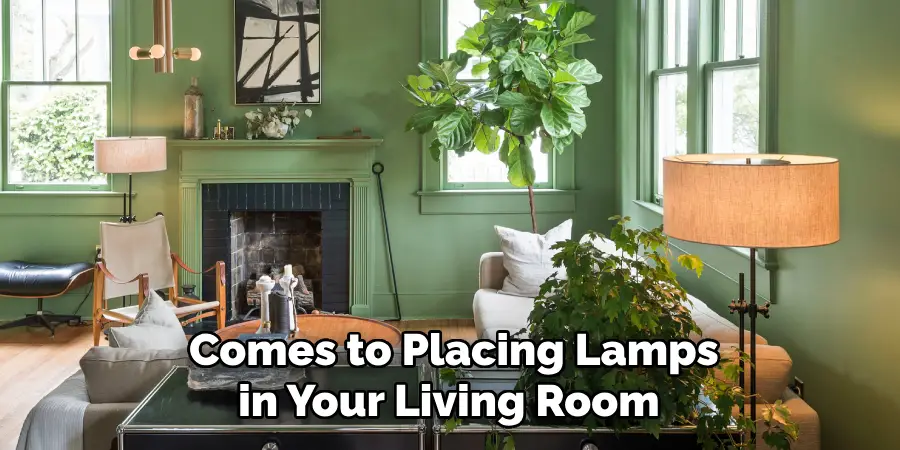
4) Mix and Match
Don’t be afraid to mix and match different types of lamps in your living room. A combination of table lamps, floor lamps, and wall sconces can create a layered and dynamic look. While they don’t have to match perfectly, make sure they complement each other in terms of style and color.
5) Consider the Shade
When choosing lampshades, consider the color and texture. A white or light-colored shade will provide a brighter light, while a darker shade can create a more intimate ambiance. Textured shades can also add visual interest to the room.
6) Use Lamps to Highlight Artwork
Placing a lamp near a piece of artwork can not only add light but also highlight and enhance its features. This is especially useful if you have a statement piece in your living room. As a general rule, the bottom of the lampshade should be at eye level with the artwork.
7) Don’t Forget Task Lighting
Aside from creating ambiance, lamps can also provide task lighting for specific activities such as reading or working on a laptop. Consider placing a floor lamp near your reading nook or a table lamp on your desk.
8) Experiment and Have Fun
Ultimately, placing lamps in your living room is all about experimenting and finding what works best for you. Don’t be afraid to try different placements and switch things up from time to time. Have fun with it, and let your personal style shine through!
Lamps are an essential element of any living room, providing both functional lighting and style. By considering the size and scale, functionality, balance, and other factors discussed in this section, you can effectively place lamps in your living room to create the perfect ambiance for any occasion.
Remember to have fun and let your personal style shine through! So go ahead and start experimenting with lamp placement in your living room today. Your space will thank you.
12 Steps on How to Place Lamps in Living Room
Step 1: Start with a Plan
Before you start placing lamps in your living room, it’s important to have a plan. Take measurements of your space and furniture, and decide where you want to add lamps. If possible, create a rough sketch or use a design tool to visualize the layout.
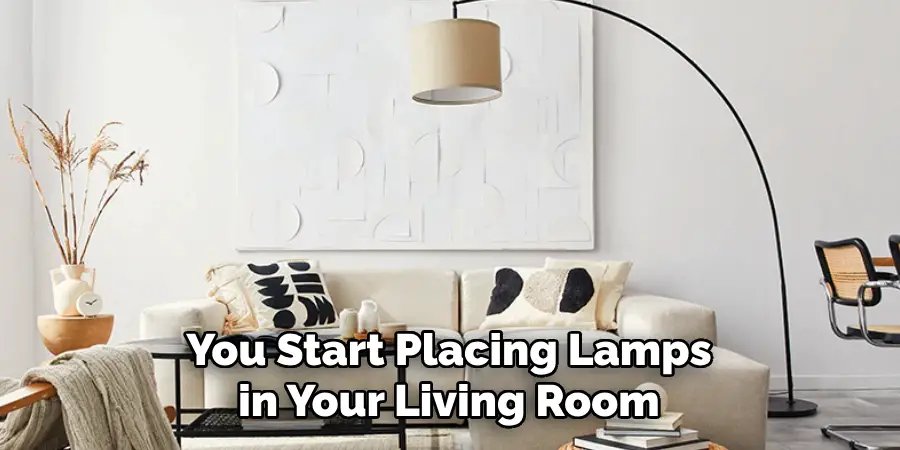
Step 2: Choose Lamps Wisely
As mentioned earlier, consider the size and scale of your living room when choosing lamps. Also, think about the style and color scheme you want to achieve. Do you want a modern look with sleek metal lamps or a more traditional feel with ceramic or wooden lamps?
Step 3: Determine the Purpose
Decide on the purpose of each lamp in your living room. Do you want it to provide general lighting or task lighting for specific activities? This will help you determine the type and placement of each lamp.
Step 4: Place Lamps Strategically
Strategically placed lamps can create a balanced and cohesive look in your living room. As a general rule, place lamps in corners or at the end of furniture to add depth and dimension to the space.
Step 5: Consider Heights
When mixing and matching different types of lamps, consider their heights. A tall floor lamp next to a short table lamp can create an interesting visual contrast. Just make sure they don’t block each other’s light.
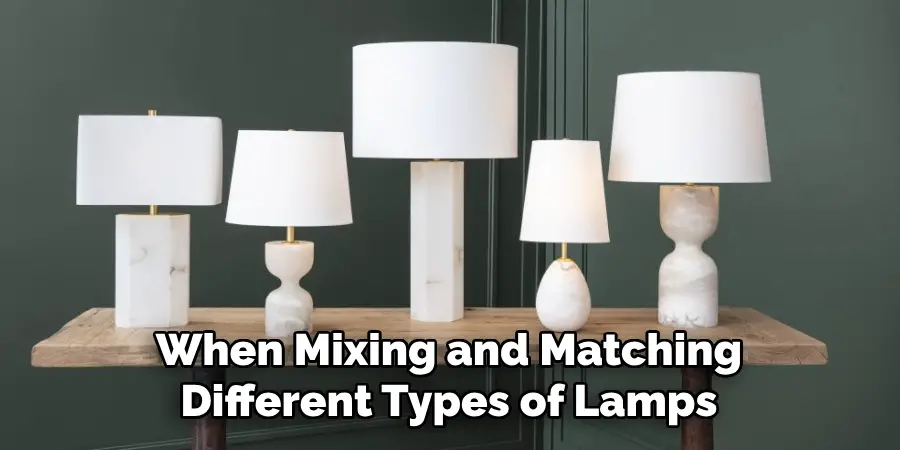
Step 6: Create Symmetry
Symmetry is pleasing to the eye and can create a sense of balance in your living room. Place lamps on either side of a sofa or bed for a symmetrical look. You can also use matching lamps on opposite sides of the room for a similar effect.
Step 7: Think About Angles
Play around with angles when placing lamps in your living room. Angling a lamp towards the wall can create a soft and diffused light while angling it toward the center of the room can provide more direct lighting.
Step 8: Don’t Overcrowd
While experimenting with different placements is encouraged, make sure not to overcrowd your living room with too many lamps. This can create a cluttered and overwhelming look. While there is no exact rule, a good guideline is to have one lamp for every 10 square feet of space.
Step 9: Add Layers
Layering different types of lighting can add depth and dimension to your living room. Consider using a combination of overhead lights, floor lamps, and table lamps to create an inviting and well-lit space.
Step 10: Incorporate Dimmers
Dimmer switches are a great way to adjust the lighting in your living room according to your needs. Consider installing them for lamps that provide general or ambient lighting. But keep in mind that not all types of bulbs are compatible with dimmers.
Step 11: Don’t Neglect Cords
With multiple lamps in your living room, cords can become a visual eyesore. Consider hiding them behind furniture or using cord covers to keep them organized and out of sight. When placing lamps, make sure to factor in the length of the cords and outlets.
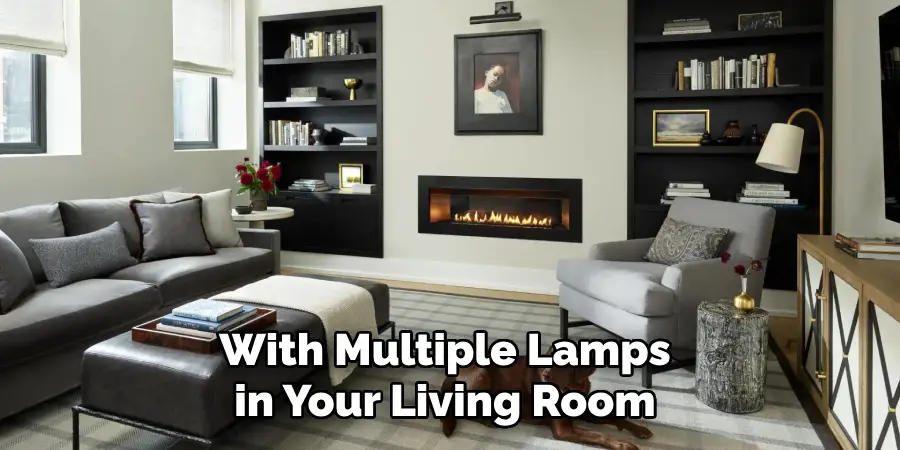
Step 12: Be Flexible
Lastly, remember that lamp placement is not set in stone. It’s okay to switch things up from time to time or rearrange your furniture and lamps for a fresh look. Don’t be afraid to experiment and have fun with it! So go ahead and start placing lamps in your living room to create the perfect ambiance for any occasion.
Experiment with different placements, layers, and styles to find what works best for you and your space. And remember, don’t be afraid to switch things up and add new lamps or replace old ones as your style evolves. Happy decorating! So go ahead and start experimenting with lamp placement in your living room today. Your space will thank you.
With these 12 steps on how to place lamps in living room, you can effectively place lamps in your living room to create the perfect ambiance for any occasion. Remember to have fun and let your personal style shine through! So go ahead and start experimenting with lamp placement in your living room today. Your space will thank you.
8 Things to Avoid When Placing Lamps
1) Avoid Overcrowding
As mentioned earlier, avoid overcrowding your living room with too many lamps. Not only can this create a cluttered and overwhelming look, but it can also make it difficult to find functional space for other items.
2) Don’t Go Too Small or Too Big
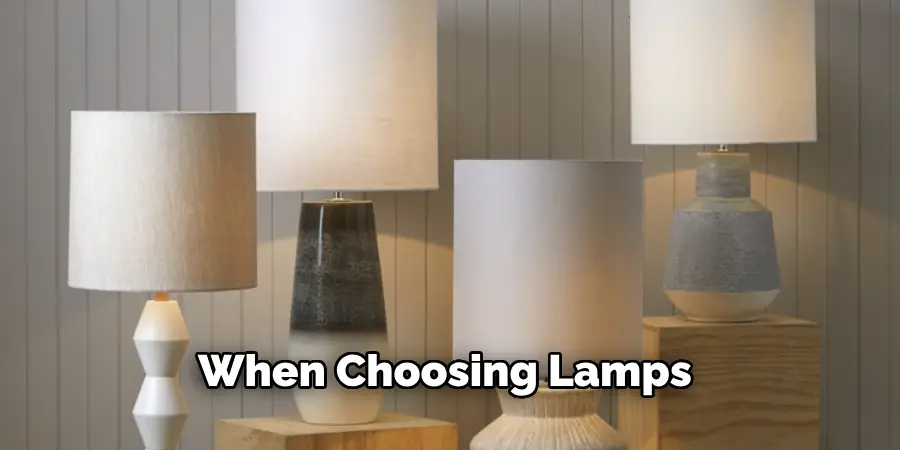
When choosing lamps, make sure they are proportional to the furniture and space. Too small lamps can get lost, while too big ones can overpower the room. Consider the size and scale of your living room when making lamp purchases.
3) Avoid Blocking Views
Placing a tall floor lamp in front of a window or blocking views with table lamps can disrupt the flow and openness of your living room. Make sure to consider sight lines when placing lamps.
4) Don’t Forget Task Lighting
While ambient lighting is important, don’t forget about task lighting for specific activities such as reading or working on a laptop. Consider incorporating table lamps or floor lamps with adjustable arms for added functionality.
5) Avoid Clashing Styles
When mixing and matching different types of lamps, make sure they complement each other and don’t clash in terms of style. This can create a disjointed and uncoordinated look in your living room. While it’s okay to mix styles, make sure they have some common elements.
6) Don’t Ignore Safety Considerations
When placing lamps, make sure they are far from flammable materials or in high-traffic areas where they can be knocked over. Also, check the wattage of bulbs and don’t exceed the recommended maximum for safety purposes.
7) Avoid Poor Placement for Reading
If you enjoy reading in your living room, make sure to place a lamp near your reading spot. This will provide adequate lighting and prevent eye strain.
8) Don’t Forget About Maintenance
Finally, don’t forget about maintaining lamps when placing them. Make sure they are easily accessible for changing bulbs and cleaning lampshades. Proper maintenance will ensure your lamps continue to provide the perfect ambiance for your living room.
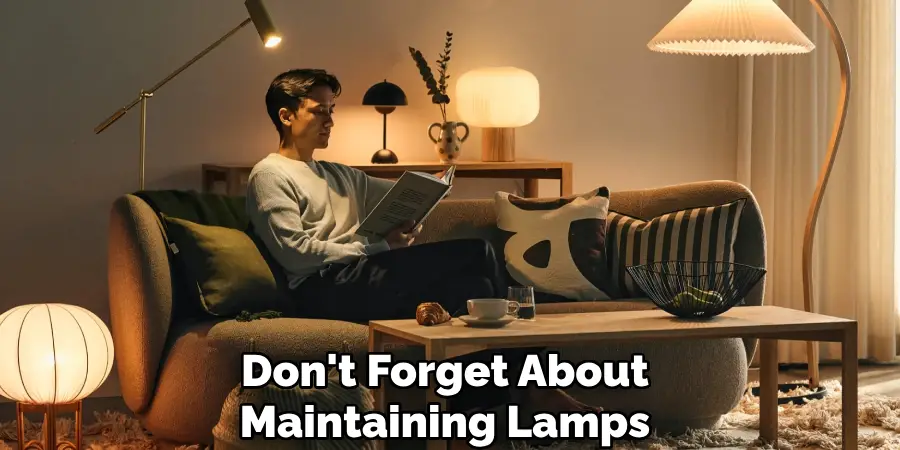
So keep these things in mind as you place and rearrange your lamps and enjoy a well-lit and beautifully decorated living room! So remember, with these tips and tricks, you can effectively place lamps in your living room to create the perfect atmosphere for any occasion. And don’t forget to have fun and let your personal style shine through! So go ahead and start experimenting with lamp placement in your living room today.
8 Additional Tips
Tip 1: Consider the Functionality
Before you start placing lamps in your living room, consider the functionality of each space. For example, if you have a designated reading nook, make sure to incorporate a lamp for task lighting. So, take some time to evaluate the different areas of your living room and what type of lighting would best serve each space.
Tip 2: Think About Proximity
When placing lamps, think about proximity to other furniture pieces. For example, if you have a sofa against a wall, make sure the table lamp on the side table is not too far away for convenient use. This will also help create a cohesive and balanced look in your room.
Tip 3: Mix Up the Heights
Having lamps at different heights adds visual interest to a room. Consider using floor lamps, table lamps, and even wall sconces to add dimension and depth to your living room. And don’t be afraid to mix up the heights within each category as well.
Tip 4: Consider Colors and Patterns
Lampshades can add an extra pop of color or pattern to your living room. Mix and match different shades to create a cohesive look, or opt for neutral shades to let the base of the lamp stand out. This is also a great way to tie in other elements of your living room’s decor.
Tip 5: Use Dimmer Switches
Installing dimmer switches for your lamps can provide more control over the ambiance of your living room. This is especially useful for cozy movie nights or dinner parties where you want a softer, more intimate lighting.
Tip 6: Utilize Mirrors
Strategically placing mirrors near lamps can help reflect and amplify the light in your living room. This can make the space feel bigger and brighter. And it’s a great way to add a decorative element as well.
Tip 7: Consider the Cord
Cords can be unsightly and disrupt the flow of your living room. Consider using cord covers or strategically placing furniture pieces to hide cords and keep them out of sight. This will create a cleaner and more polished look in your space.
Tip 8: Experiment with Different Bulbs
Different types of bulbs can create different lighting effects. Consider experimenting with warm or cool-toned light bulbs to see which creates the desired ambiance in your living room. And don’t forget to regularly change out old bulbs for optimal lighting.
So keep these additional tips on how to place lamps in living room in mind as you perfect your lamp placement and enjoy a well-lit and beautifully decorated living room! Happy decorating! So remember, with these tips and tricks, you can effectively place lamps in your living room to create the perfect atmosphere for any occasion. And don’t forget to have fun and let your personal style shine through!
Frequently Asked Questions
Can I Mix and Match Different Styles of Lamps?
Yes, as long as they complement each other in terms of style and have some common elements. Don’t be afraid to mix and match different heights, shapes, and colors for added visual interest.
How Many Lamps Should I Have in my Living Room?
The number of lamps you should have in your living room depends on the size and layout of the space. As a general rule, aim for at least three sources of lighting (such as overhead lights, floor lamps, and table lamps) to create a well-lit and balanced room.
Is Task Lighting Necessary?
Task lighting is not necessary, but it can add functionality to your living room. Consider incorporating task lighting for specific activities such as reading or working on a laptop. This can be achieved with table lamps or floor lamps with adjustable arms.

What is Task Lighting?
Task lighting refers to a specific type of lighting that is designed to provide focused and directional light for completing tasks. This type of lighting is often used in areas where additional illumination is needed, such as reading nooks or home offices.
Conclusion
Lamps are an essential element in creating a cozy and inviting living room. By considering factors such as placement, functionality, and maintenance, you can effectively incorporate lamps into your living room decor. And don’t forget to have fun and let your personal style shine through!
So remember, with these tips and tricks on how to place lamps in living room, you can effectively place lamps in your living room to create the perfect atmosphere for any occasion. So remember, with these tips and tricks, you can effectively place lamps in your living room to create the perfect atmosphere for any occasion. And don’t forget to have fun and let your personal style shine through!

